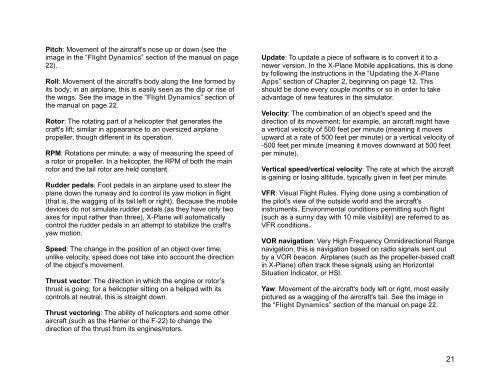X-Plane Helicopter Manual - X-Plane.com
X-Plane Helicopter Manual - X-Plane.com
X-Plane Helicopter Manual - X-Plane.com
- No tags were found...
Create successful ePaper yourself
Turn your PDF publications into a flip-book with our unique Google optimized e-Paper software.
Pitch: Movement of the aircraft's nose up or down (see theimage in the “Flight Dynamics” section of the manual on page22).Roll: Movement of the aircraft's body along the line formed byits body; in an airplane, this is easily seen as the dip or rise ofthe wings. See the image in the “Flight Dynamics” section ofthe manual on page 22.Rotor: The rotating part of a helicopter that generates thecraft's lift; similar in appearance to an oversized airplanepropeller, though different in its operation.RPM: Rotations per minute; a way of measuring the speed ofa rotor or propeller. In a helicopter, the RPM of both the mainrotor and the tail rotor are held constant.Rudder pedals: Foot pedals in an airplane used to steer theplane down the runway and to control its yaw motion in flight(that is, the wagging of its tail left or right). Because the mobiledevices do not simulate rudder pedals (as they have only twoaxes for input rather than three), X-<strong>Plane</strong> will automaticallycontrol the rudder pedals in an attempt to stabilize the craft'syaw motion.Speed: The change in the position of an object over time;unlike velocity, speed does not take into account the directionof the object's movement.Thrust vector: The direction in which the engine or rotor’sthrust is going; for a helicopter sitting on a helipad with itscontrols at neutral, this is straight down.Thrust vectoring: The ability of helicopters and some otheraircraft (such as the Harrier or the F-22) to change thedirection of the thrust from its engines/rotors.Update: To update a piece of software is to convert it to anewer version. In the X-<strong>Plane</strong> Mobile applications, this is doneby following the instructions in the “Updating the X-<strong>Plane</strong>Apps” section of Chapter 2, beginning on page 12. Thisshould be done every couple months or so in order to takeadvantage of new features in the simulator.Velocity: The <strong>com</strong>bination of an object's speed and thedirection of its movement; for example, an aircraft might havea vertical velocity of 500 feet per minute (meaning it movesupward at a rate of 500 feet per minute) or a vertical velocity of-500 feet per minute (meaning it moves downward at 500 feetper minute).Vertical speed/vertical velocity: The rate at which the aircraftis gaining or losing altitude, typically given in feet per minute.VFR: Visual Flight Rules. Flying done using a <strong>com</strong>bination ofthe pilot's view of the outside world and the aircraft'sinstruments. Environmental conditions permitting such flight(such as a sunny day with 10 mile visibility) are referred to asVFR conditions.VOR navigation: Very High Frequency Omnidirectional Rangenavigation; this is navigation based on radio signals sent outby a VOR beacon. Airplanes (such as the propeller-based craftin X-<strong>Plane</strong>) often track these signals using an HorizontalSituation Indicator, or HSI.Yaw: Movement of the aircraft's body left or right, most easilypictured as a wagging of the aircraft's tail. See the image inthe “Flight Dynamics” section of the manual on page 22.21














